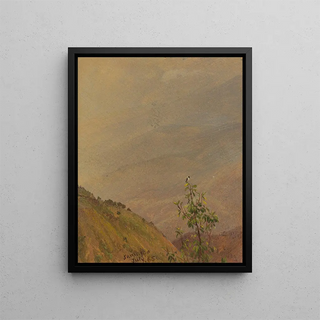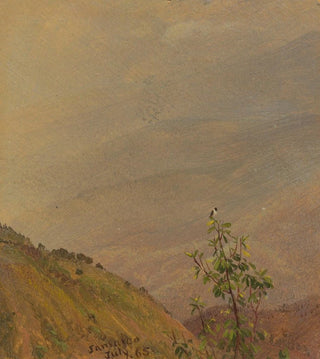Landscape Painting VI - Frederic Edwin Church | Art print


View from behind

Frame (optional)
Paysage VI - Frederic Edwin Church – Captivating introduction
In the vast panorama of art history, certain works stand out for their ability to capture the very essence of nature and transport the viewer into a world of sublime beauty. "Paysage VI - Frederic Edwin Church" is one of these creations that, through its visual richness and evocative atmosphere, invites deep contemplation. This piece, emblematic of the American Romantic movement of the 19th century, bears witness to the harmony between man and nature, while revealing the technical mastery of its creator. Immersing oneself in this universe, one cannot help but feel a surge of wonder at the magnificence of the depicted landscapes, where every detail seems to vibrate with its own life.
Style and uniqueness of the work
Frederic Edwin Church's style is characterized by meticulousness and precision that give his landscapes an almost photographic dimension. In "Paysage VI," the colors intertwine with rare delicacy, creating a play of light that pays homage to the splendor of nature. The skies, often dramatic, are painted with such intensity that they seem to move, while the earth, mountains, and water are rendered with a fidelity that borders on the sublime. The work also stands out for its bold use of contrasts, where shadows and lights clash to create an atmosphere that is both serene and dynamic. This landscape invites attentive exploration, where each corner reveals a new facet of nature, blending realism and idealism in perfect harmony.
The artist and his influence
Frederic Edwin Church, a central figure of the Hudson River School, managed to leave his mark on his era through his commitment to representing American nature. His work is not limited to a simple art print of landscapes but is part of a spiritual and philosophical quest, seeking to evoke the grandeur of creation. Church traveled across America and beyond, drawing inspiration from the varied landscapes he encountered, from majestic mountains to lush valleys. His influence extends far beyond his time, inspiring many contemporary and future artists to embrace the beauty of nature in their own

Matte finish

View from behind

Frame (optional)
Paysage VI - Frederic Edwin Church – Captivating introduction
In the vast panorama of art history, certain works stand out for their ability to capture the very essence of nature and transport the viewer into a world of sublime beauty. "Paysage VI - Frederic Edwin Church" is one of these creations that, through its visual richness and evocative atmosphere, invites deep contemplation. This piece, emblematic of the American Romantic movement of the 19th century, bears witness to the harmony between man and nature, while revealing the technical mastery of its creator. Immersing oneself in this universe, one cannot help but feel a surge of wonder at the magnificence of the depicted landscapes, where every detail seems to vibrate with its own life.
Style and uniqueness of the work
Frederic Edwin Church's style is characterized by meticulousness and precision that give his landscapes an almost photographic dimension. In "Paysage VI," the colors intertwine with rare delicacy, creating a play of light that pays homage to the splendor of nature. The skies, often dramatic, are painted with such intensity that they seem to move, while the earth, mountains, and water are rendered with a fidelity that borders on the sublime. The work also stands out for its bold use of contrasts, where shadows and lights clash to create an atmosphere that is both serene and dynamic. This landscape invites attentive exploration, where each corner reveals a new facet of nature, blending realism and idealism in perfect harmony.
The artist and his influence
Frederic Edwin Church, a central figure of the Hudson River School, managed to leave his mark on his era through his commitment to representing American nature. His work is not limited to a simple art print of landscapes but is part of a spiritual and philosophical quest, seeking to evoke the grandeur of creation. Church traveled across America and beyond, drawing inspiration from the varied landscapes he encountered, from majestic mountains to lush valleys. His influence extends far beyond his time, inspiring many contemporary and future artists to embrace the beauty of nature in their own
12,34 €






